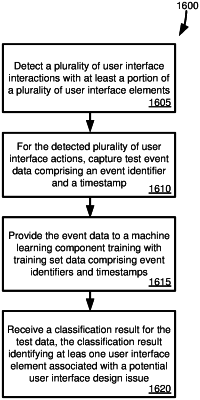| CPC G06N 20/00 (2019.01) [G06F 9/453 (2018.02); G06F 11/3438 (2013.01); G06F 17/18 (2013.01); G06F 18/2148 (2023.01); G06F 18/24 (2023.01)] | 20 Claims |

|
16. One or more non-transitory computer-readable storage media comprising:
computer-executable instructions that, when executed by a computing system comprising at least one hardware processor and at least one memory coupled to the at least one hardware processor, cause the computing system to receive training data comprising a plurality of training user interface interaction records, the training user interface interaction records comprising event identifiers and timestamps;
computer-executable instructions that, when executed by the computing system, cause the computing system to train a regression-based machine learning component using the training data;
computer-executable instructions that, when executed by the computing system, cause the computing system to receive test data comprising at least one test user interface interaction record, the test user interface record comprising an event identifier and a timestamp, wherein the event identifier identifies at least one user interface element associated with the test user interface record and the timestamp comprises temporal information of the at least one user interface element;
computer-executable instructions that, when executed by the computing system, cause the computing system to, with the trained machined learning component, determine that the at least one user interface element is associated with a user interface element interaction time having greater than a threshold difference from a value associated with the machine learning component; and
computer-executable instructions that, when executed by the computing system, cause the computing system to render a display based on the determining that the user interface element interaction time has greater than a threshold difference, the display comprising a user interface element associated with the user interface element interaction time or an identifier of a user interface element associated with the user interface element interaction time.
|